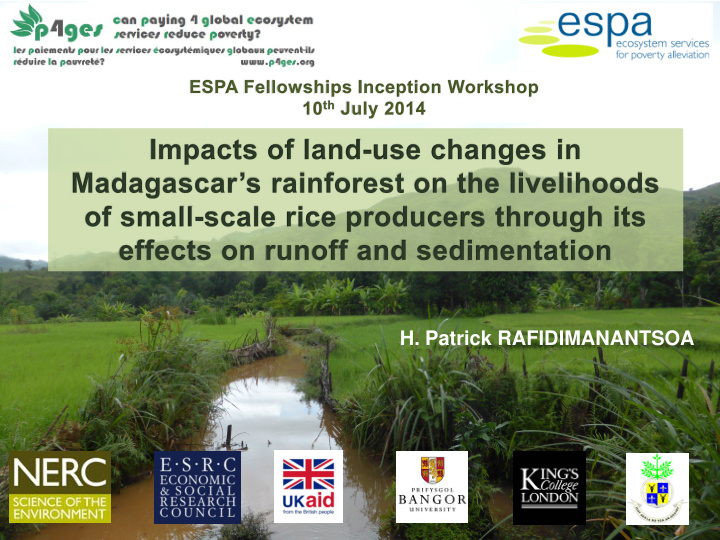



H. Patrick RAFIDIMANANTSOA
OUTLINE 1. Overview 2. Research design and Methods 3. Outcomes 4. Supervisory structure 5. Progress and time schedule 1
1. Overview Low income country • • 92.6 % people with < $2/day (World Bank, 2013) Human Development rank = 151/186 (UNDP, 2013) • • Gross National Income per capita = $430 (2011) (World Bank, 2013)) Regularly exposed to cyclones AND political • crises have slowed development 2
1. Overview (cont.) • Rice calories intake : 51% (IRRI, 2009) • 63 % of Malagasy HH are small-scale rice farmers (INSTAT, 2013) 3
1. Overview (cont.) • New Protected Area • 381,000 ha REDD+, Reforestation projects • • Pressures: slash- and-burn cultivation, mining • Agricultural plains on both sides A. Shepard - Conservation International - May 2012 4
2. Research design and Methods My three research questions RQ 1: How does forest cover influence runoff and sedimentation load damages in the agricultural plains? RQ 2: What are the costs of sediment build-up and runoff damages to local farmers? RQ 3: To what extent is forest cover likely to influence the livelihoods of small-scale rice producers? 5
2. Research design and Methods (cont.) p4ges and my work Hydro team Dry season flows Forest Agriculture: cover Impacts on Runoff damage rice producers and Global PES sedimentation Land-use SE team changes in Local welfare costs CAZ due to flooding events Local welfare costs and sedimentation due to restrictions of forest use and access SE team Main Target = Rice Poverty Farmers’ alleviation livelihoods p4ges my work 6
2. Research design and Methods (cont.) RQ 1: How does forest cover influence runoff damage and sedimentation load in the agricultural plains? Scenario Analyses WaterWorld Maps Baseline Alter. Scen. vs Spatial data Site identification RQ 2: What are the net costs of runoff damage and sediment build-up to local farmers? Eco. Crop loss Focus Group Interviews valuation discussion Coping mech. technique RQ 3: To what extent is forest cover likely to influence the livelihoods of small- scale rice producers? Synthesis 7
3. Outcomes of the fellowship • Research outputs: Scientific papers • Applied value of the research: Policy briefs • New capacity in Madagascar 8
4. Supervisory structure Dr Julia Jones Dr Mark Mulligan Dr Mahesh Poudyal Prof Bruno Ramamonjisoa Lead mentor Economic valuation of environmental Scientific writing, Hydrological services and social research overall management modelling methods 9
5. Progress and proposed time schedule Since 1 st June 2014 : • Meetings with mentors • Literature review • WaterWorld applications 10
5. Progress and proposed time schedule (cont.) 2014 JUNE JULY AUG SEPT ESPA Events attendance Lit. review on forest hydrology Scenario analyses Writing “Intro.” and “Method.” Report for ESPA 2015 SEPT OCT NOV DEC Refining costs estimates methods Ethics Questionnaire design and test Ground-truthing in Mada Adjustment of field protocol Report for ESPA 11
5. Progress and proposed time schedule (cont.) 2016 J F M A M J J A S O N D Data collection in Madagascar Processing field data Writing & validation of Results Writing & validation of Discussions Writing & validation of Conclusions Submit paper manuscripts Writing of policy briefs Final report for ESPA 12
THANK YOU FOR YOUR ATTENTION! h.rafidimanantsoa@bangor.ac.uk rafidimanantsoa.patrick@gmail.com
Recommend
More recommend